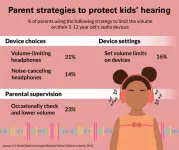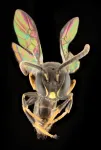(Press-News.org) When you get a tattoo, do you know what you’re putting under your skin? According to new Binghamton University research, the ingredient labels on tattoo ink don’t match the actual substances in the bottle.
Produced by the lab of Binghamton Univerity Assistant Professor of Chemistry John Swierk, “What’s in my ink: An analysis of commercial tattoo ink on the U.S. market” was recently published in the journal Analytical Chemistry.
Swierk’s lab explores the potential impact of light on tattoos and their chemical breakdown. Early on, doctoral student Kelli Moseman — the article’s lead author, along with Ahshabibi Ahmed and Alexander Ruhren — noticed that the tattoo inks they were researching contained substances that weren’t on the label. Were they breakdown products from the interaction with light or something in the ink from the start? What’s actually in a bottle of tattoo ink?
The researchers analyzed tattoo inks from nine manufacturers in the United States and compared their actual contents with the label. The manufacturers ran the gamut from major, global companies to smaller producers; the inks in question came in six colors.
Of the 54 inks, 45 of them — 90% — had major discrepancies with the labeled contents, such as different pigments than the ones listed or unlisted additives.
More than half contained unlisted polyethylene glycol, which can cause organ damage through repeated exposure, while 15 contained propylene glycol, a potential allergen. Other contaminates included an antibiotic commonly used to treat urinary tract infections and 2-phenoxyethanol, which poses potential health risks to nursing infants.
Their research cannot identify whether unlisted ingredients were added intentionally or if the manufacturer was provided with incorrectly labeled or contaminated materials.
“We’re hoping the manufacturers take this as an opportunity to reevaluate their processes, and that artists and clients take this as an opportunity to push for better labeling and manufacturing,” Swierk said.
Swierk noted that the research on the safety implications of tattoos is still out. Allergic reactions are the most common negative outcome, and they can be persistent, painful and even disfiguring, he said. Red pigments are a particular problem, although science hasn’t yet determined why.
Regulatory concerns
Potential risks associated with tattooing usually focus on skin cancer and the pigments themselves, but additives can also cause risks — including some beyond the skin. If a client begins to develop issues related to the tattoo weeks or even years later, unlisted ingredients can make it difficult to figure out what reaction is happening and why.
Regulation of tattoo inks on the American market is very recent. At the end of 2022, Congress passed the Modernization of Cosmetics Regulation Act (MoCRA), which allowed the federal Food and Drug Administration to regulate tattoo inks for the first time, including accurate labeling practices; prior to that, tattoo inks were considered cosmetic in nature and not subject to regulation.
“The FDA is still figuring out what that is going to look like and we think this study will influence the discussions around MoCRA,” Swierk said. “This is also the first study to explicitly look at inks sold in the United States and is probably the most comprehensive because it looks at the pigments, which nominally stay in the skin, and the carrier package, which is what the pigment is suspended in.
Their study focused only on substances at 2,000 parts per million (ppm) or more, considered high concentrations. European regulations, however, consider substances in the 2 ppm range. In other words, there could be even more substances in the inks than the ones the lab found.
The tattoo inks available in the American and European markets differ because the latter is subject to stricter regulations, overseen by the European Chemicals Agency.
In the future, the lab will investigate pigments banned in Europe and see if those components are present in tattoo inks sold there, Moseman said. She is currently working on a study focused on blue and green inks sold in Europe, which have been particularly affected by chemical regulations.
“Our goal in a lot of this research is to empower artists and their clients. Tattoo artists are serious professionals who have dedicated their lives to this craft and they want the best possible outcomes for their clients,” Swierk said. “We’re trying to highlight that there are some deficiencies in manufacturing and labeling.”
END
Tattoo inks don’t match the ingredients listed on the bottle
2024-02-26
ELSE PRESS RELEASES FROM THIS DATE:
May I have a quick word? Study shows talking faster is linked to better brain health as we age
2024-02-26
As we get older, we may start to notice it takes us longer to find the right words. This can lead to concerns about cognitive decline and dementia.
However, a new study by Baycrest and the University of Toronto suggests that talking speed is a more important indicator of brain health than difficulty finding words, which appears to be a normal part of aging. This is one of the first studies to look at both differences in natural speech and brain health among healthy adults.
“Our results indicate that changes in general talking speed may reflect changes in the brain,” says Dr. Jed Meltzer, ...
Vanishing forests and suffering children: The hidden toll of deforestation in Cambodia
2024-02-26
Deforestation, a critical consequence of human activity, has garnered significant attention due to its impact on environmental sustainability, biodiversity and climate change. However, an equally pressing yet less explored aspect is the relationship between deforestation and human health, especially in impoverished regions. Scientists have increasingly recognized the detrimental effects of deforestation on various aspects of human health, particularly among children. Studies reveal that children residing in areas with high deforestation rates are at an elevated risk of malaria, ...
Birth outcomes improve in states that extend driver’s licenses to undocumented immigrants, research finds
2024-02-26
In 2023, Rhode Island, Massachusetts and Minnesota joined a growing list of states that allow undocumented immigrants to obtain driver’s licenses if an applicant can provide certain documentation, such as a foreign birth certificate or passport and evidence of current residency in the state. Altogether, 19 states and the District of Columbia have similar legislation in place. And lawmakers in other states, such as Michigan and Oklahoma, have introduced similar legislation.
In many cases, these laws were passed ...
First-in-humans discovery reveals brain chemicals at work influencing social behavior
2024-02-26
In a study in today’s (Monday Feb. 26) Nature Human Behavior, scientists delve into the world of chemical neuromodulators in the human brain, specifically dopamine and serotonin, to reveal their role in social behavior.
The research, conducted in Parkinson's disease patients undergoing brain surgery while awake, homed in on the brain’s substantia nigra, a crucial area associated with motor control and reward processing.
Led by Virginia Tech computational neuroscientist Read Montague, the international team revealed ...
Shifting focus: Investigators describe changes to pancreatic β cell at onset of Type 1 Diabetes
2024-02-26
BOSTON – About eight million people live with Type 1 diabetes (T1D) worldwide, a chronic autoimmune condition in which the body attacks and destroys its own insulin-producing β-cells (pronounced “beta”) in the pancreas, leading to a lack of insulin and inability to regulate blood sugar. It’s not known why the body suddenly perceives its own β-cells as the enemy; some lines of evidence suggest environmental factors such as viral infections may trigger the onset of T1D, others suggest genetics may also play some role.
Groundbreaking ...
Award-winning researcher dreams of stellar explosions and strives for equity and inclusion in academia
2024-02-26
She studies the giant explosions of dying stars and dreams of experiencing and extracting data from a supernova close to Earth. Professor Irene Tamborra from the Niels Bohr Institute also tirelessly promotes equity and inclusion in research. Today she receives the prestigious Elite Research Prize and DKK 1.2 million in honor of her research in astrophysics.
"I am fascinated by anything that explodes in the sky," Professor Irene Tamborra says as she begins to describe her research. The professor from the University of Copenhagen’s ...
Clinical trial tests combination antibody therapy in adults with advanced cancer
2024-02-26
In an early phase clinical trial, a combination of antibody-based medications targeting the immune system generated promising safety data and anti-tumor activity in individuals with various types of advanced cancer. The findings are published by Wiley online in CANCER, a peer-reviewed journal of the American Cancer Society.
Both medications tested in the trial support immune responses against tumor cells. CS1002 increases the activation and proliferation of T immune cells by binding to a T cell receptor called CTLA-4. CS1003, also called nofazinlimab, ...
Birds and bee lessons as Pacific field trips also solve 'Michener's mystery'
2024-02-26
Eight new Pacific bee species and new insights into Fijian bird behaviour on Viti Levu Island have been described in new scientific studies led by Flinders University.
The studies, both funded by field work supported by the Australian Government’s New Colombo Mobility Plan Program, highlight the potential for species discovery, ecological and conservation knowledge and cultural engagement from Asia-Pacific research collaborations.
In the past 10 years, Australian Government-funded Flinders University field trips have worked closely ...
Can they hear you now? Kids increasingly exposed to noise health risks via earbuds and headphones
2024-02-26
ANN ARBOR, Mich. – While it’s not surprising to spot teens wearing headphones and earbuds, it’s also becoming a widespread trend among younger children, a national poll suggests.
Two in three parents say their child ages 5-12 uses personal audio devices, with half of parents of children ages 5-8 reporting elementary-aged kids use a device.
Among parents whose children use headphones and earbuds, half say kids spend at least an hour a day using them while one in six say a typical ...
How did a tiny bee get to French Polynesia? Eight new species help solve a scientific mystery
2024-02-26
In 1934, American entomologist Elwood Zimmerman, then an undergraduate student at Berkeley, participated in the ‘Mangarevan expedition’ to Polynesia. Among the samples he collected were three tiny (4 mm long), orange-brown solitary bees found on tahetahe flowers in the Tuamotu Archipelago.
The specimens rested undisturbed in the Bernice P Bishop Museum of Honolulu until 1965, when the famous bee specialist Prof Charles Michener examined them. He described them as a species new to science: Hylaeus tuamotuensis, or Tuamotu’s masked bee, in the family ...






